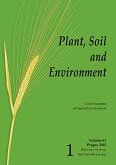Ver ítem
- xmlui.general.dspace_homeCentros Regionales y EEAsCentro Regional Salta - JujuyEEA SaltaArtículos científicosxmlui.ArtifactBrowser.ItemViewer.trail
- Inicio
- Centros Regionales y EEAs
- Centro Regional Salta - Jujuy
- EEA Salta
- Artículos científicos
- Ver ítem
Relationship between microbial functions and community structure following agricultural intensification in South American Chaco
Resumen
Intensification of agricultural systems through the use of intensive agriculture and the advance of deforestation have led to a decrease of soil biological quality. Soil functional and structural microbiota are sensitive parameters to monitor changes caused by agricultural use. Different sites under soybean monoculture (continuous soybean) and soybean/maize rotation practices were selected. Samples were collected from agricultural soils under different
[ver mas...]
Intensification of agricultural systems through the use of intensive agriculture and the advance of deforestation have led to a decrease of soil biological quality. Soil functional and structural microbiota are sensitive parameters to monitor changes caused by agricultural use. Different sites under soybean monoculture (continuous soybean) and soybean/maize rotation practices were selected. Samples were collected from agricultural soils under different periods of implantation: 4-year rotation; 15-year rotation; 5-year monoculture; and 24-year monoculture (M24). A site of native vegetation recently under agricultural production (RUA) was also sampled. Native vegetation soils (NV) adjacent to agricultural sites were sampled as a control. In general, the results showed that RUA and M24 had lower enzyme activities, less microbial abundance and low physical and chemical soil quality than those subjected to crop rotation. In contrast, both the bacterial and total microbial biomasses were significantly higher in NV and crop rotation than in soils under monoculture systems. Although it was expected that differences in microbial activities would be due to changes in microbial community abundance, the results indicated that changes in soil management produced faster alterations to soil enzyme activities than any modifications induced in the microbial community structure. Consequently, both aspects of microbial diversity, namely function and structure, were affected independently by agricultural intensification.
[Cerrar]

Autor
Perez Brandan, Carolina;
Huidobro, Dina Jorgelina;
Galvan, Marta Zulema;
Vargas Gil, Silvina;
Meriles, Jose Manuel;
Fuente
Plant soil and environment 62 (7) : 321-328. (July 2016)
Fecha
2016-07
Editorial
Czech Academy of Agricultural Sciences
ISSN
1214-1178
1805-9368 (Online)
1805-9368 (Online)
Formato
pdf
Tipo de documento
artículo
Palabras Claves
Derechos de acceso
Abierto
 Excepto donde se diga explicitamente, este item se publica bajo la siguiente descripción: Creative Commons Attribution-NonCommercial-ShareAlike 2.5 Unported (CC BY-NC-SA 2.5)
Excepto donde se diga explicitamente, este item se publica bajo la siguiente descripción: Creative Commons Attribution-NonCommercial-ShareAlike 2.5 Unported (CC BY-NC-SA 2.5)


